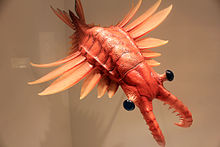Anomalocaris
| Anomalocaris | ||||||||||||
|---|---|---|---|---|---|---|---|---|---|---|---|---|

First completely preserved Anomalocaris find, from the Royal Ontario Museum |
||||||||||||
| Temporal occurrence | ||||||||||||
| early and middle Cambrian | ||||||||||||
| 530 to 501 million years | ||||||||||||
| Locations | ||||||||||||
|
||||||||||||
| Systematics | ||||||||||||
|
||||||||||||
| Scientific name | ||||||||||||
| Anomalocaris | ||||||||||||
| Whiteaves , 1892 | ||||||||||||
| species | ||||||||||||
|
||||||||||||
Anomalocaris ("unusual shrimp") is a genus of the Anomalocarida , a group of extinct, marine, invertebrate animals without a fixed systematic classification, whichmay be close tothe arthropods . Anomalocaris was in the period of the early and middle Cambrian (530 to 501 million years ago) with a length between 60 and 120 centimeters, the largest animal known from that time.
Body features
Anomalocaris swam in the water and used movable flap-like appendages on the body to help them move. His head had a pair of up to 3 cm large, perhaps connected, long stalk eyes. These could consist of several hundred or even several thousand lenses and their structure was similar to the compound eyes of today's insects and crabs. This made them one of the largest and sharpest visual organs ever.
With two exceptionally agile claws on the disc-shaped mouth opening, Anomalocaris was probably able to grab prey and carry it to the mouth. However, the latest research suggests that the mouth of Anomalocaris was not suitable for the consumption of hard food, as it had no teeth, only soft horn plates. In addition, the mouth could not be closed, which suggests that Anomalocaris may have only sucked in its food.
Reconstruction and allied genera
Anomalocaris was often misclassified. So isolated fossil finds of the circular mouth were mistaken for a jellyfish and called Peytoia . The body was thought to be a sponge and was named Laggania . The claws have also been described as a genus of arthropods. Ultimately, however, the animal Anomalocaris could be reconstructed. After further fossil finds in the Burgess schist , the image of the animal became clearer, later another species was discovered in China, Anomalocaris saron , alongside the American Anomalocaris canadiensis . Other related genera have also been described, including, for example, Amplectobelua , also a Chinese anomalocarid. Another representative of the anomalocarids is Schinderhannes bartelsi - especially because he lived about 100 million years later in the lower Devonian and thus considerably extends the geological lifetime of this group.
Systematics
Because of numerous unique characteristics, it is still not clear where the anomalocarids, which meanwhile form a family of their own, are to be classified in the systematics of invertebrates. An order was created, the Radiodonta, in which one tried to accommodate the Anomalocarids and their relatives, for example Opabinia ; However, they cannot yet be specifically classified into a tribe or even a class. A proposed solution for this was the establishment of the class Dinocaridita, which is superior to the Radiodonta, and the classification of this in the tribe of Lobopods . However, this is usually only seen as a not yet applicable approach. Possibly they form a side branch of the arthropods that split off and specialized already at the beginning of the early Cambrian.
literature
- Stephen Jay Gould : Chance Man. The miracle of life as a game of nature . Hanser , Munich 1991, ISBN 3-446-15951-7 .
- Ernst Peter Fischer : The great book of evolution . Fackelträger-Verl., Cologne 2008, ISBN 978-3-7716-4373-7 .
- Geo-Magazin 01/2011 p. 174 . Gruner + Jahr AG, Hamburg
Web links
- Animation in 3D
- Fossils
- Information on Anomalocaris and related genera ( Memento from 23 August 2006 in the Internet Archive )
Individual evidence
- ↑ YuanYuan Wang, DiYing Huang and ShiXue Hu: New anomalocardid frontal appendages from the Guanshan biota, eastern Yunnan . In: Chinese Science Bulletin . 58, No. 32, 2013, pp. 3937-3942. doi : 10.1007 / s11434-013-5908-x .
-
^ John R. Paterson et al .: Acute vision in the giant Cambrian predator Anomalocaris and the origin of compound eyes. In: Nature , Volume 480, No. 7376, 2011, pp. 237-240, doi: 10.1038 / nature10689
The eye animal of the Cambrian. In: Frankfurter Allgemeine Zeitung of December 14, 2011, page N2 - ↑ Primordial Shrimp: Super eyes led deadly hunters to prey. SPIEGEL-ONLINE, accessed on December 9, 2011 .
- ↑ Lost and Found, No. 1058: Ur-Shrimp caused horror. n-tv Online, accessed December 9, 2011 .

